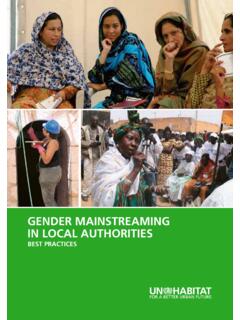Transcription of SOUTH AFRICAN DECLARATION ON THE PREVENTION AND …
1 1 SOUTH AFRICAN DECLARATION ON THE PREVENTION AND CONTROL OF NON- communicable DISEASES We, the participants in the SOUTH AFRICAN Summit on the PREVENTION and Control of Non- communicable diseases gathered in Gauteng from 12-13 September 2011. Recognising that: - Health is a key development goal; SOUTH Africa principally suffers from a quadruple burden of disease: from HIV and AIDS and TB, high levels of Maternal and Child mortality; Intentional and non-intentional injuries; and Non- communicable diseases; Achieving a long and healthy life for all requires concerted interventions in each of these areas best achieved through an inter-sectoral collaboration based on sound evidence. A shift towards a whole of government and a whole of society approach is imperative in dealing with Non- communicable Diseases given Non- communicable Diseases are caused or strongly influenced by behavioural, environmental, social and economic factors.
2 The right of all SOUTH Africans to the enjoyment of the highest attainable standards of physical and mental health and acknowledge that this cannot be achieved without increased measures and services at national, provincial and district levels to prevent and control Non- communicable Diseases. In order to achieve equitable, efficient and quality health services SOUTH Africa is in the process of implementing a National Health Insurance System and that PREVENTION , early detection and universal treatment of Non- communicable Diseases will form an integral part of this system. Noting that: - Non- communicable diseases impact on every strata of SOUTH AFRICAN society; men and women, all races, economic groups, urban and rural populations and age groups - including children, adolescents and older persons. Significant mortality and burden of disease is attributable to cardiovascular diseases, diabetes, cancers, chronic respiratory diseases, mental disorders, oral and eye diseases, muscular skeletal and other non- communicable conditions.
3 Non- communicable Diseases are the leading cause(s) of preventable morbidity and disability, and currently cause over 60% of global deaths, 80% of which occur in developing countries and that by 2030, Non- communicable Diseases are estimated to contribute to 75% of global deaths. Non- communicable diseases are also responsible for high disability adjusted life years. 2 In Africa Non- communicable Diseases are anticipated to overtake mortality from communicable , maternal, perinatal and nutritional diseases by SOUTH Africa in 2000 Non- communicable diseases were responsible for around 40% of all deaths (excluding injury) and around 35% of the burden of disease. People living with HIV and AIDS are at higher risk for developing Non- communicable Diseases including cancers, heart disease, mental disorder, diabetes and other Non- communicable Diseases. Maternal and child health are inextricably linked with Non- communicable Diseases and their risk factors and that prenatal malnutrition and low birth weight create a predisposition for obesity, high blood pressure, heart disease and diabetes later in life and Non- communicable Diseases in pregnancy create risks for both mother and child.
4 More than half of people who have hypertension and diabetes in SOUTH Africa are not aware of their condition; there are around 17 million visits at health centres per annum for these conditions, resulting in significant health care costs and use of human resources. Improved primary health care would reduce visits to secondary and tertiary health care facilities. SOUTH Africa has adopted Tobacco Control measures, but need to address other major risk factors for non- communicable diseases. Non- communicable diseases have economic consequences on individuals, households and society. Affirm that: - The major Non- communicable Diseases are linked to common risk factors, namely unhealthy diets (high intake of fats, salt, sugar etc), physical inactivity, harmful use of alcohol, tobacco use, and in some cases infections. Unequal development including poverty and health illiteracy is strongly associated with increased NCD morbidity and mortality.
5 Realize that: - The common risk factors and the systems put in place to deal with the conditions in which people live are shaped by social, cultural, behavioural, environmental and economic determinants. Primary health care is the foundation of the health care system. 3 There is a the need to fully integrate non- communicable diseases into the re-engineering of Primary Health care in SOUTH Africa with the view to increasing community based PREVENTION , screening, self management, care (including rehabilitation and palliative care) and referral according to the WHO innovative model for chronic care. Informed by: - Resolutions on the PREVENTION and control of non- communicable diseases and on PREVENTION and control of non- communicable diseases: The implementation of the global strategy on Non- communicable Diseases The report of the WHO Commission on Social Determinants of Health (2008); The Ouagadougou DECLARATION on Primary Health Care and Health Systems in Africa (2008); The Libreville DECLARATION on Health and Environment (2008); The Nairobi Call to Action for Health Promotion (2009); The Mauritius Call for Action on Diabetes, Cardiovascular Diseases and Non- communicable Diseases (2009); The WHO Framework Convention on Tobacco Control (FCTC-2003); The Action Plan for the Global Strategy for the PREVENTION and Control of Non- communicable Diseases; The WHO Global Strategy to Reduce the Harmful Use of Alcohol (2010).
6 The Global Strategy on Diet, Physical Activity and Health and other relevant international strategies to address Non- communicable Diseases; WHO guidelines on advertising to children; Resolution on Diet, Physical Activity and Health (WHA ) UN Convention on the rights of people with Disabilities (200 WHO Vision 20/20 PREVENTION of Blindness Programme ( WHO (PEN) 4 WHO Strategy on Integrated palliative Care. Madrid International plan of Action on Ageing (2002). Hereby commit to:- Using the outputs from the summit to develop a full and comprehensive strategic plan. Create an intersectoral stakeholder forum similar to SANAC to implement this strategy. Fostering patient-centred health care in line with the SA Patients Rights Charter and incorporating respect, involvement in policy, choice and empowerment, access and support and information Workingin partnership with all relevant stakeholders including different government departments, non-governmental organizations, user and survivor groups, academics and content experts as well as with private sector stakeholders that commit themselves to reduce Non- communicable Diseases and do not have a conflict of interest, to reduce the incidence and mortality from non- communicable diseases; Introducing evidence based behavioural interventions and campaigns through the media and other information and education mechanisms to reduce the acquisition and increase health literacy amongst SOUTH AFRICAN consumers to reduce the main modifiable risk factors for non- communicable diseases.))
7 Developing multi-sectoral public policies that create sustainable health promoting environments that enable individuals, families and communities to make healthy choices and lead healthy lives; Developing and implementing policies, strategies, plans and evidence based guidelines at national, provincial and district levels in and across government departments to prevent and control Non- communicable Diseases through preventive, health promoting, curative, rehabilitative and palliative services; Strengthening the national health system as the basis of a comprehensive and sustainable approach to equitable health outcomes for Non- communicable Diseases ensuring quality care across the life cycle; Introducing legislation and regulation to reduce the acquisition and increase modifiable risk factors for Non- communicable Diseases 5 Reducing costs and increase the efficiency of health interventions, including making medicines, devices and vaccines affordable, in order to provide essential health services, including preventive services, for Non- communicable Diseases to all; Increasing PREVENTION , screening and control programmes for Non- communicable Diseases and where feasible integrate these with those provided for chronic communicable health conditions and maternal and child health services; Establishing comprehensive surveillance mechanisms, health information systems and dissemination processes to assist policy, planning and management of NCD PREVENTION and control.
8 Developing, encouraging and supporting research and innovation in Non- communicable Diseases to improve understanding of the burden, determinants, causes and consequences; PREVENTION , screening and control of Non- communicable Diseases in all age groups; Implementing the WHO Framework Convention on Tobacco Control, the Action Plan for the Global Strategy for the PREVENTION and Control of Non- communicable Diseases; the WHO Global Strategy to Reduce the Harmful Use of Alcohol, and the Global Strategy on Diet, Physical Activity and Health. Increasing public awareness of the early signs and symptoms of Non- communicable Diseases in order to promote timely health seeking behaviour. Increasing the numbers of people who have established family and community food gardens Improving the quality of food available in SOUTH Africa by means of intersectoral collaborations. Developing and strengthening human capacity for chronic disease research and monitoring.
9 Increasing human resources for detection, management, PREVENTION and control of non- communicable diseases and build links with traditional and complementary healers. And consequently to: 1) Reduce by at least 25% the relative premature mortality (under 60 years of age) from Non- communicable Diseases by 2020. 2) Reduce by 20% tobacco use by 2020. 3) Reduce by 20% the relative per capita consumption of alcohol by 2020. 4) Reduce mean population intake of salt to < 5grams per day by 2020. 6 5) Reduce by 10% the percentage of people who are obese and/or overweight by 2020. 6) Reduce the prevalence of people with raised blood pressure by 20% by 2020 (through lifestyle and medication). 7) Screen all women at least every 5 years for cervical cancer by 2020 8) Screen all men above 40 years of age for prostate cancer by 2020 9) Increase the percentage of people controlled for hypertension, diabetes and asthma by 30% by 2020 10) Increase the number of people screened and treated for mental health by 30% by 2030 7








